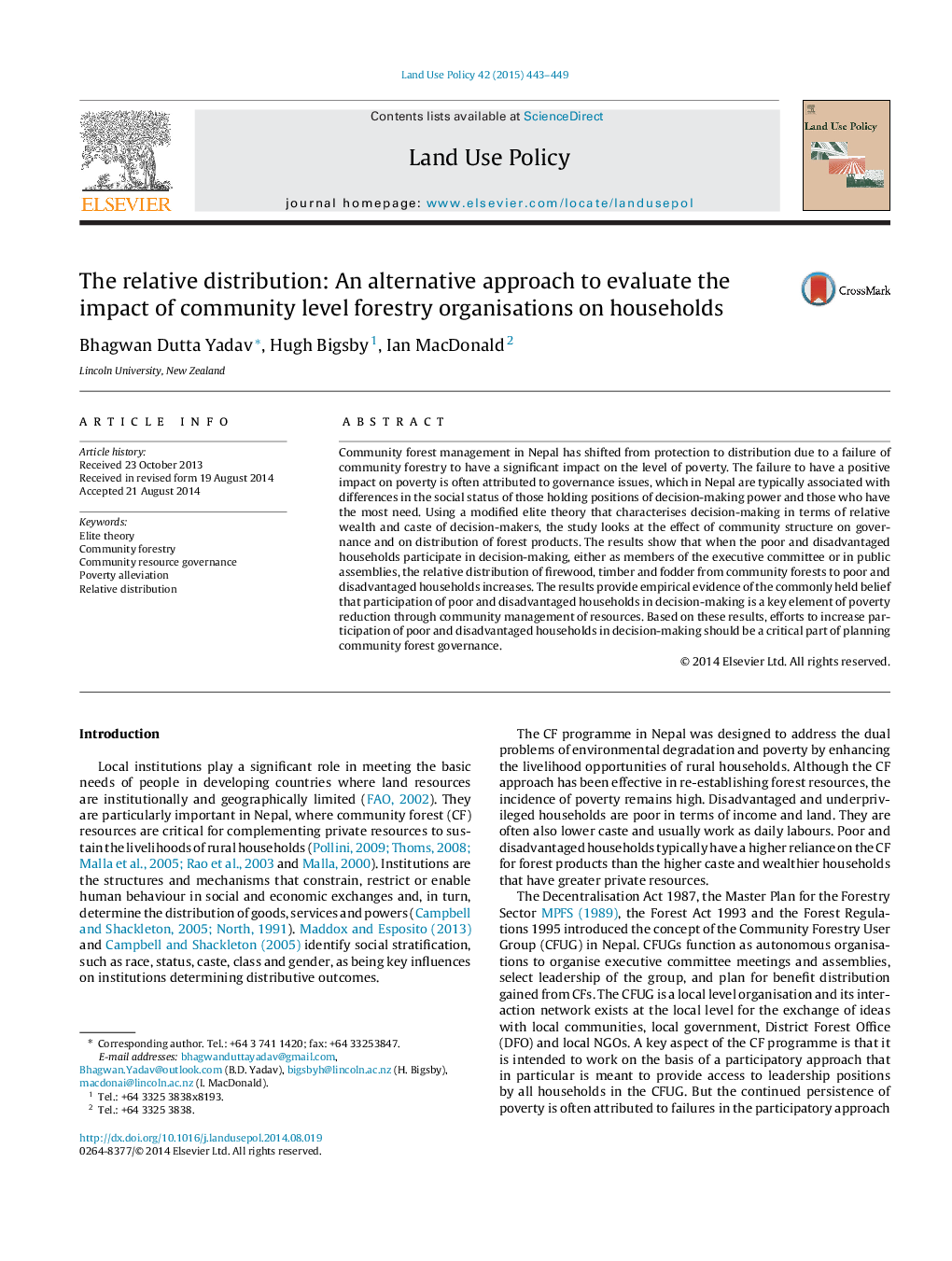| کد مقاله | کد نشریه | سال انتشار | مقاله انگلیسی | نسخه تمام متن |
|---|---|---|---|---|
| 6548435 | 160106 | 2015 | 7 صفحه PDF | دانلود رایگان |
عنوان انگلیسی مقاله ISI
The relative distribution: An alternative approach to evaluate the impact of community level forestry organisations on households
ترجمه فارسی عنوان
توزیع نسبی: یک رویکرد جایگزین برای ارزیابی تأثیرات سازمان های جنگلی در سطح جامعه در خانواده ها
دانلود مقاله + سفارش ترجمه
دانلود مقاله ISI انگلیسی
رایگان برای ایرانیان
کلمات کلیدی
نظریه نخبگان، انجمن جنگلداری، حکومت منابع انسانی، کاهش فقر، توزیع نسبی،
ترجمه چکیده
مدیریت جنگل های محلی در نپال از نظر حفاظت به توزیع به دلیل نابودی جنگل های محلی تاثیر قابل توجهی بر سطح فقر گذاشته است. ناتوانی در تأثیر مثبتی بر فقر، اغلب به مسائل مربوط به حکومت مربوط می شود که در نپال به طور معمول با تفاوت ها در وضعیت اجتماعی کسانی که دارای قدرت های تصمیم گیری و کسانی هستند که بیشترین نیاز را دارند، مرتبط است. با استفاده از یک نظریه اصلاح نخبگان که ویژگی تصمیم گیری را از لحاظ ثروت نسبی و تصمیم گیرندگان تصمیم گیری می کند، مطالعه به بررسی تأثیر ساختار جامعه بر مدیریت و توزیع محصولات جنگلی می پردازد. نتایج نشان می دهد که هنگامی که خانواده های فقیر و محروم در تصمیم گیری مشارکت می کنند، یا به عنوان اعضای کمیته اجرایی یا مجمع عمومی، توزیع نسبی هیزم، چوب و خوراک از جنگل های محلی به خانواده های فقیر و محروم افزایش می یابد. نتایج نشان می دهد شواهد تجربی از اعتقاد رایج که مشارکت خانوار فقیر و محروم در تصمیم گیری، یک عنصر کلیدی کاهش فقر از طریق مدیریت جامعه منابع است. بر اساس این نتایج، تلاش برای افزایش مشارکت خانواده های فقیر و محروم در تصمیم گیری باید بخش مهمی از برنامه ریزی برای مدیریت جنگل های محلی باشد.
موضوعات مرتبط
علوم زیستی و بیوفناوری
علوم کشاورزی و بیولوژیک
جنگلداری
چکیده انگلیسی
Community forest management in Nepal has shifted from protection to distribution due to a failure of community forestry to have a significant impact on the level of poverty. The failure to have a positive impact on poverty is often attributed to governance issues, which in Nepal are typically associated with differences in the social status of those holding positions of decision-making power and those who have the most need. Using a modified elite theory that characterises decision-making in terms of relative wealth and caste of decision-makers, the study looks at the effect of community structure on governance and on distribution of forest products. The results show that when the poor and disadvantaged households participate in decision-making, either as members of the executive committee or in public assemblies, the relative distribution of firewood, timber and fodder from community forests to poor and disadvantaged households increases. The results provide empirical evidence of the commonly held belief that participation of poor and disadvantaged households in decision-making is a key element of poverty reduction through community management of resources. Based on these results, efforts to increase participation of poor and disadvantaged households in decision-making should be a critical part of planning community forest governance.
ناشر
Database: Elsevier - ScienceDirect (ساینس دایرکت)
Journal: Land Use Policy - Volume 42, January 2015, Pages 443-449
Journal: Land Use Policy - Volume 42, January 2015, Pages 443-449
نویسندگان
Bhagwan Dutta Yadav, Hugh Bigsby, Ian MacDonald,
